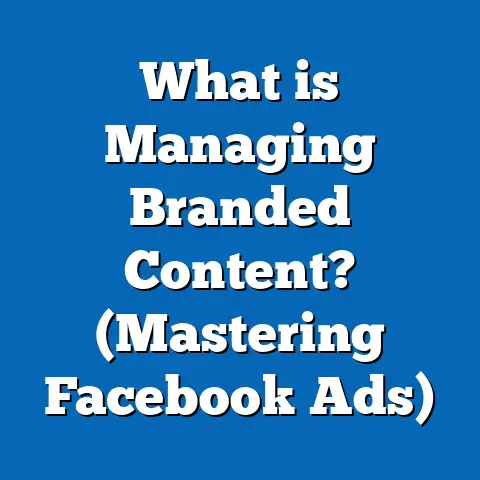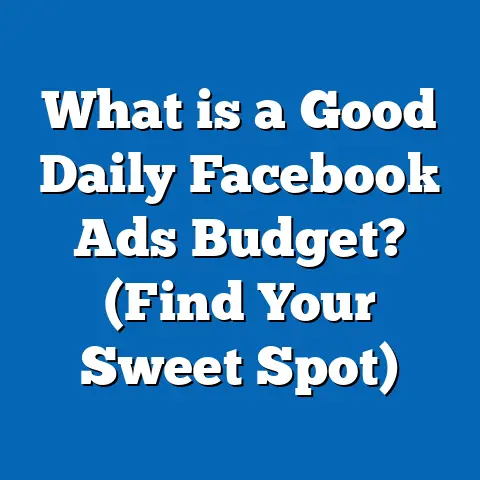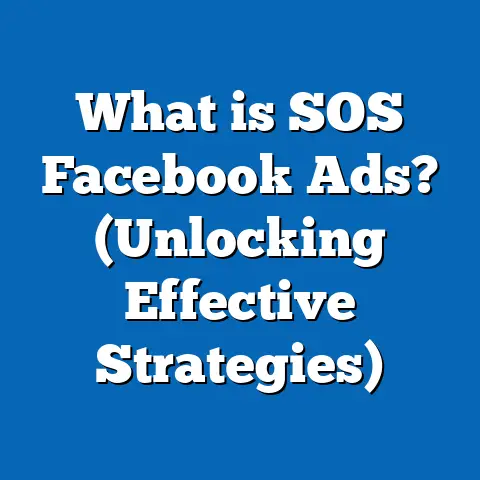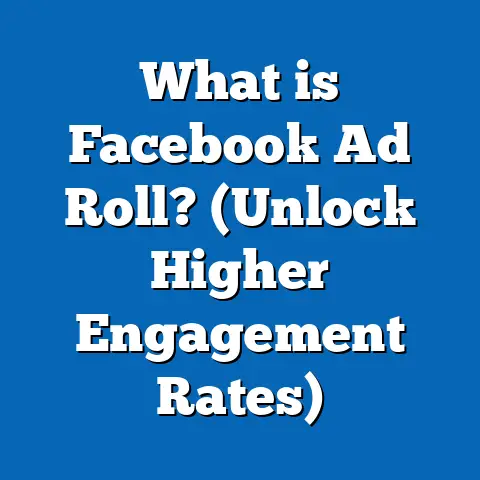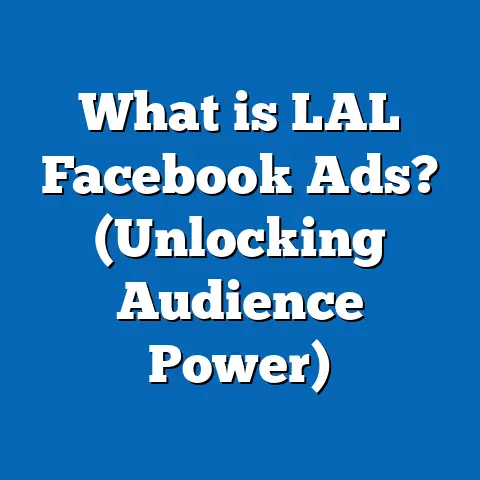What is Facebook Ads Policy? (Essential Rules for Success)
What is Facebook Ads Policy? (Essential Rules for Success)
Introduction: The Power of Long-Term Savings Through Facebook Ads Policy Compliance
Advertising on Facebook offers access to a vast and engaged audience, making it one of the most powerful marketing platforms available today. However, the key to turning this opportunity into sustained success lies in understanding and adhering to Facebook’s Ads Policy. While it may seem like just a set of rules, compliance with these policies saves businesses significant time, money, and reputation damage over the long term.
Non-compliance can cause ads to be disapproved or accounts suspended, disrupting campaigns and wasting advertising budgets. On the other hand, mastering Facebook’s policies reduces ad rejection rates, improves campaign performance metrics such as click-through rates (CTR) and conversion rates, and ensures a trustworthy brand image. This guide will explore the Facebook Ads Policy comprehensively, breaking down complex guidelines into actionable strategies for marketing professionals and business owners alike.
Why Facebook Ads Policy is Essential for Advertisers
The Scale and Influence of Facebook Advertising
- Global Reach: Facebook has approximately 2.96 billion monthly active users worldwide (Q1 2024), including users on Instagram and Messenger integrated under Meta.
- Advertising Spend: Businesses collectively spend over $150 billion annually on Facebook ads.
- Ad Variety: Offers multiple formats—image ads, videos, carousel ads, stories, dynamic product ads, lead generation forms, and more.
This scale means even minor policy violations can have amplified consequences, affecting millions of potential customers and leading to costly disruptions.
Cost Implications of Non-Compliance
A recent survey by AdEspresso found that:
- About 28% of Facebook advertisers experienced at least one ad rejection per campaign cycle.
- Each rejected ad or account suspension can delay campaigns by an average of 2 weeks.
- Account bans can result in loss of access to previously built audiences and historical data, requiring costly rebuilding efforts.
By following policies from the start, advertisers reduce these risks significantly, saving both time and money.
Building User Trust and Brand Reputation
Facebook’s policies focus heavily on user safety and trust. Ads that comply with these rules foster positive user experiences that translate into better brand perception. According to a Nielsen study:
- 64% of consumers say they are more likely to buy from brands that respect their privacy and avoid misleading claims.
- Ads that comply with Facebook’s policies tend to generate higher engagement rates.
Detailed Overview of Facebook Ads Policy
Facebook’s Ads Policy is a multi-faceted framework designed to regulate what advertisers can promote, how they do it, and who they can target. It is continuously updated to reflect evolving industry standards, legal requirements, and user expectations.
1. Prohibited Content: What You Must Never Advertise
Facebook prohibits ads containing certain types of content outright. This category aims to protect users from illegal or harmful materials.
Key Prohibited Content Areas:
- Illegal Products or Services: Ads promoting drugs (recreational or unapproved pharmaceuticals), counterfeit goods, stolen property, or human trafficking are banned.
- Discriminatory Practices: Ads cannot discriminate based on race, ethnicity, religion, age, gender identity, sexual orientation, disability status, or other protected characteristics.
- Adult Content: Nudity and sexually explicit content are disallowed unless they meet strict educational or artistic exceptions.
- Misleading or False Claims: Ads must not contain deceptive or unsubstantiated claims that could mislead users.
- Violence and Hate Speech: Content that promotes hate groups or violent acts is strictly forbidden.
Data Point:
Facebook removed over 1.5 million ads globally in 2023 due to violations related to prohibited content.
2. Restricted Content: Allowed With Conditions
Certain types of content are allowed only under specific circumstances and compliance requirements.
Examples of Restricted Content:
- Alcohol: Allowed only in countries where legal; ads must target users above legal drinking age.
- Gambling & Betting: Require prior approval from Facebook; must include disclaimers about responsible gambling.
- Financial Services: Ads for loans or credit products require clear terms and disclaimers about risks.
- Weight Loss Products: Must avoid unrealistic claims; focus on healthy lifestyle promotion.
Case Study:
A health supplement company revised their ad copy from “Guaranteed weight loss” to “Supports healthy metabolism” to meet policy requirements. This change reduced ad disapproval rates by 40%, improving campaign efficiency.
3. Ad Creative & Copy Guidelines: How Your Ads Should Look and Sound
Facebook expects advertisers to maintain high standards for creative quality and messaging clarity.
Critical Creative Rules:
- No Sensationalism: Avoid exaggerated offers or ‘too good to be true’ statements.
- Transparency: Clearly disclose any sponsored or branded content.
- Avoid Clickbait: Headlines must accurately represent the ad content without misleading users.
- Image Text Limits: Images should contain minimal text—Facebook recommends keeping text under 20% of the image area for best delivery.
Practical Tip:
Use Facebook’s Text Overlay Tool during ad creation to check if your image text meets guidelines.
4. Targeting Restrictions: Who You Can Reach
Facebook provides granular targeting options but restricts certain targeting practices for ethical reasons.
Key Targeting Prohibitions:
- No targeting based on sensitive personal data without explicit user consent (e.g., health conditions, political beliefs).
- No targeting minors for products inappropriate for their age group.
- Prohibited use of targeting that results in exclusionary or discriminatory practices.
Example:
A real estate advertiser attempting to exclude specific racial groups from their audience was flagged and suspended due to violation of anti-discrimination policies.
5. Technical Requirements: Making Your Ad Work Seamlessly
Facebook enforces technical standards to optimize user experience and ad performance:
- Landing Page Quality: The destination URL must function correctly and match the advertised offer.
- Tracking Compliance: Proper use of Facebook Pixel and Conversions API is required without violating user privacy.
- Video & Image Specs: Follow resolution, aspect ratio, and length guidelines for different ad formats.
Data Insights: How Compliance Influences Performance Metrics
Approval Rates & Campaign Efficiency
According to internal Facebook data:
- Advertisers following best practices have an average approval rate of over 95%.
- Non-compliant ads face a 3x higher risk of rejection.
Engagement & Conversion Impact
An independent study by HubSpot revealed:
- Compliant ads had a 20% higher CTR than non-compliant ads.
- Conversion rates improved by 15% when ads adhered strictly to policy guidelines.
Cost Efficiency
Facebook’s auction system favors high-quality ads with relevant content:
- Ads with high relevance scores often enjoy up to 30% lower cost-per-click (CPC).
- Policy-compliant campaigns experience fewer interruptions, reducing wasted spend.
How Facebook Enforces Its Ads Policy
Understanding enforcement mechanisms helps advertisers anticipate potential challenges.
Automated Review System
Facebook uses an AI-powered system that scans all new ads for policy violations within seconds. It checks:
- Text content for banned keywords
- Image recognition for prohibited visuals
- Landing page scanning for compliance
This system handles billions of ad impressions daily and flags suspicious ads for manual review.
Human Review Process
When AI flags an ad as suspicious or unclear:
- A team of trained reviewers assesses context and nuances.
- Reviewers consider advertiser history and previous violations.
This two-tier system balances speed with fairness.
Appeals Process
Advertisers can request reconsideration if their ads are disapproved:
- Typically resolved within 24–48 hours.
- Some complex cases take longer but Facebook has been investing in faster resolutions.
Practical Applications: Real World Examples & Lessons Learned
Example 1: E-commerce Brand Avoids Suspension by Revising Ad Copy
Scenario: A fashion retailer’s ad claimed “100% organic cotton” without certification. Facebook flagged the ad as misleading.
Action Taken: The brand updated copy to “Made with high-quality cotton,” adding certifications on the landing page.
Outcome: The ad was approved immediately; sales increased by 12% due to restored campaign momentum.
Example 2: Financial Service Provider Navigates Complex Approval Process
Scenario: A loan company’s ad was initially rejected due to unclear terms.
Solution: The company added clear disclaimers about interest rates and repayment terms as required by policy.
Result: After approval, the campaign saw a 25% increase in lead quality and a reduction in customer complaints.
Advanced Understanding: Staying Ahead with Policy Updates & New Features
Facebook updates its policy regularly to address new challenges:
Recent Key Changes (2024)
- Stricter cryptocurrency advertising rules require pre-certification.
- New transparency rules for political ads demand detailed disclaimers.
- Weight loss product ads now emphasize body positivity and avoid unrealistic promises.
Utilizing Facebook Business Tools
Advertisers should integrate:
- Facebook Ad Library: To monitor competitor ads and understand compliance trends.
- Facebook Business Suite: Offers insights into ad performance alongside policy adherence notifications.
Preparing for Future Trends
With increasing regulatory scrutiny worldwide (e.g., GDPR in Europe), Facebook is expected to enhance privacy rules further. Advertisers must stay agile by monitoring official announcements regularly.
How Facebook Ads Policy Compares With Other Platforms
| Aspect | Facebook Ads Policy | Google Ads Policy | LinkedIn Ads Policy |
|---|---|---|---|
| Content Restrictions | Strict on health claims, discrimination | Similar restrictions but stricter on medical claims | Focuses on professional integrity; less strict on lifestyle |
| Review Speed | Near-instant AI + human review | Instant AI + human audits | Primarily human reviews; slower but thorough |
| Targeting Limits | Sensitive data restrictions enforced | Strong controls on health & financial targeting | Professional demographic targeting with compliance checks |
| Transparency Tools | Ad Library for public view | Transparency Center | Campaign analytics dashboards |
| Appeals Process | Available with typically fast turnaround | Available; sometimes slower | Available but less transparent |
Each platform has nuances; however, Facebook’s balance of automation and human review is industry-leading in efficiency.
Strategic Recommendations for Marketers & Business Owners
- Audit Your Existing Campaigns Regularly: Identify any potential policy violations before launching new campaigns.
- Train Your Team on Policy Updates: Ensure everyone involved understands key rules—especially copywriters and designers.
- Use Facebook’s Tools Actively: Test creatives with the Text Overlay Tool; monitor competitor ads via Ad Library.
- Build Clear Documentation for Appeals: Document ad changes and have rationale ready if appeals are needed.
- Prioritize User Experience: Always deliver honest content aligned with your brand values to earn trust over time.
Summary: Key Takeaways for Facebook Ads Policy Success
| Takeaway | Explanation |
|---|---|
| Understand core prohibited content | Never advertise illegal or harmful products |
| Use restricted content wisely | Follow local laws & get approvals when required |
| Craft clear, honest creatives | Avoid exaggerated claims & misleading images |
| Respect targeting limits | Avoid discrimination & protect user privacy |
| Follow technical requirements | Ensure landing pages work & proper tracking setup |
| Monitor policy updates continuously | Stay informed about changes & new features |
| Leverage Facebook tools | Use Ad Library & Text Overlay Tool |
| Plan for appeals | Respond promptly to disapprovals |
Next Steps: How You Can Implement These Insights Today
- Conduct a thorough review of your current ads against Facebook’s policies.
- Train your marketing team using this guide as a reference document.
- Create a checklist based on prohibited/restricted content tailored to your industry.
- Regularly visit Facebook’s official Business Help Center for updates.
- Use data insights from past campaigns to refine your creative approach and targeting strategies.
By embedding these practices into your workflow, you will not only avoid costly errors but also improve the effectiveness of your campaigns sustainably.
If you want additional resources such as industry-specific compliance checklists or sample ad copies perfectly aligned with policies, just ask!

